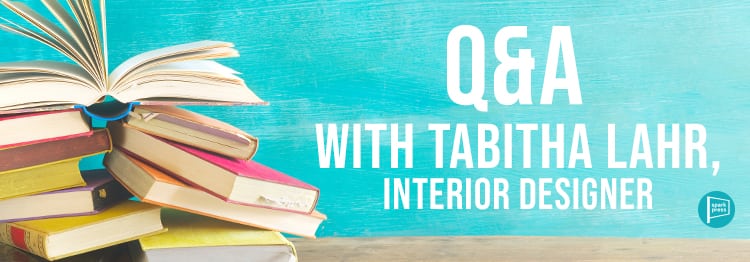
At SparkPress and She Writes Press, we have a wonderful team of interior designers who make your book look amazing. There’s a lot that goes into building a book’s interior design and formatting, to make it look just as good as your cover and affect readers just as much as your story. Have you ever wondered how long a typical design process takes? How a designer chooses the little nuances in chapter titles and page breaks?
Well, one of our talented designers is long-time graphic artist Tabitha Lahr—and she’s here to answer some of your burning questions about what it is she does!
What’s your favorite thing about designing a book’s interior?
Matching the feeling of the book to the tone and elements of the cover design, because it I enjoy creating one cohesive visually appealing package!
How are you seeing interior design evolve during your career?
I imagine that new software will be developed where print books and ebooks are simultaneously created as one file, and you would have the choice to export it as either a print or digital file. InDesign currently sort of does this, but it hasn’t been refined yet and falls short, so PDFs are still being sent to conversion houses for ebooks to be made.
How do you figure out the feel for a book’s tone?
By referencing the final chosen front cover design. Due to the lack of time, reading the full manuscript during production is a luxury for an interior designer, so we rely on the overall tone that is conveyed from the cover.
How do you pick the right font?
The same fonts that are on the cover (or similar ones) are used in the interior on the title pages, as chapter openers, and headings. The body font (all of the text except for headings) is chosen from a group of more neutral serif fonts that compliment, but it’s main importance is its readability. A proper body font choice will not stand out to the eye, but instead it’s appearance is easily forgotten by the reader as they absorb the content. For headings, sometimes the fonts need to be varied in size, boldness, and italicized versus roman, to give the feeling of an organized hierarchy.
What sort of software do you use?
I use a few programs from Adobe Creative Cloud Suite, which is a subscription-based program service. The majority of the interior is created in InDesign. This is the program the manuscript is imported into, margins are defined, and is the type is set. The final printer-ready PDF file is then created as an export.
If there are any images within the book, they are optimized in Photoshop, which includes color correction or editing, conversion to grayscale, checking of resolution, and sizing.
If any charts need to be updated, this would typically be done in Illustrator.
What is the most challenging part of designing an interior?
For a memoir or novel, the most challenging part is controlling orphans and widows. To eliminate them, text is often tracked in (the spacing between characters is reduced) or tracked out (the spacing between the characters is increased). It can sometimes be difficult to correct an orphan or widow without making the text look too loose (too much spacing between characters) or tight (too little spacing between characters). And improper or excessive hyphenation is often a result as well, which needs to be monitored and corrected.
For a self-help book, with different levels of headings, sidebars, lists, and images, the main challenge is to properly organize the content so that it is easily understood, while also designing it to look attractive, and remaining within the target page count length.
What does the design process look like?
An interior designer is sent the manuscript, and any other applicable materials such as photos, as well as the final cover design choice. The book’s trim size and margins are set up in InDesign, and then the manuscript Word document is imported into the file. Fonts choices are made and all of the text is styled throughout, while monitoring for orphans, widows, and incorrect or excessive hyphenation. If the page count length is too long and needs to be shortened, adjustments are made such as smaller margins, decreased body font size, and decreased spacing between the text lines. Readability is extremely important and kept in mind when making reductions, as well as not reducing the margins too far. The gutter (inside margin) needs to be a minimum of .8125” so that you don’t lose any of the text during binding process. The outside margin needs to be a minimum of .75” because that’s the amount of space the average thumb takes up. You don’t want the reader’s thumb to cover any of the text when holding the book open.
How long does it take you to design the interior of a book?
For an average length memoir of novel of approximately 300 pages and no special formatting (charts, lists, letter extracts) it takes me about 5 to 8 hours. For a self-help book with multi-elements and photos, it can take anywhere from 8 to 30 hours.

Leave A Comment